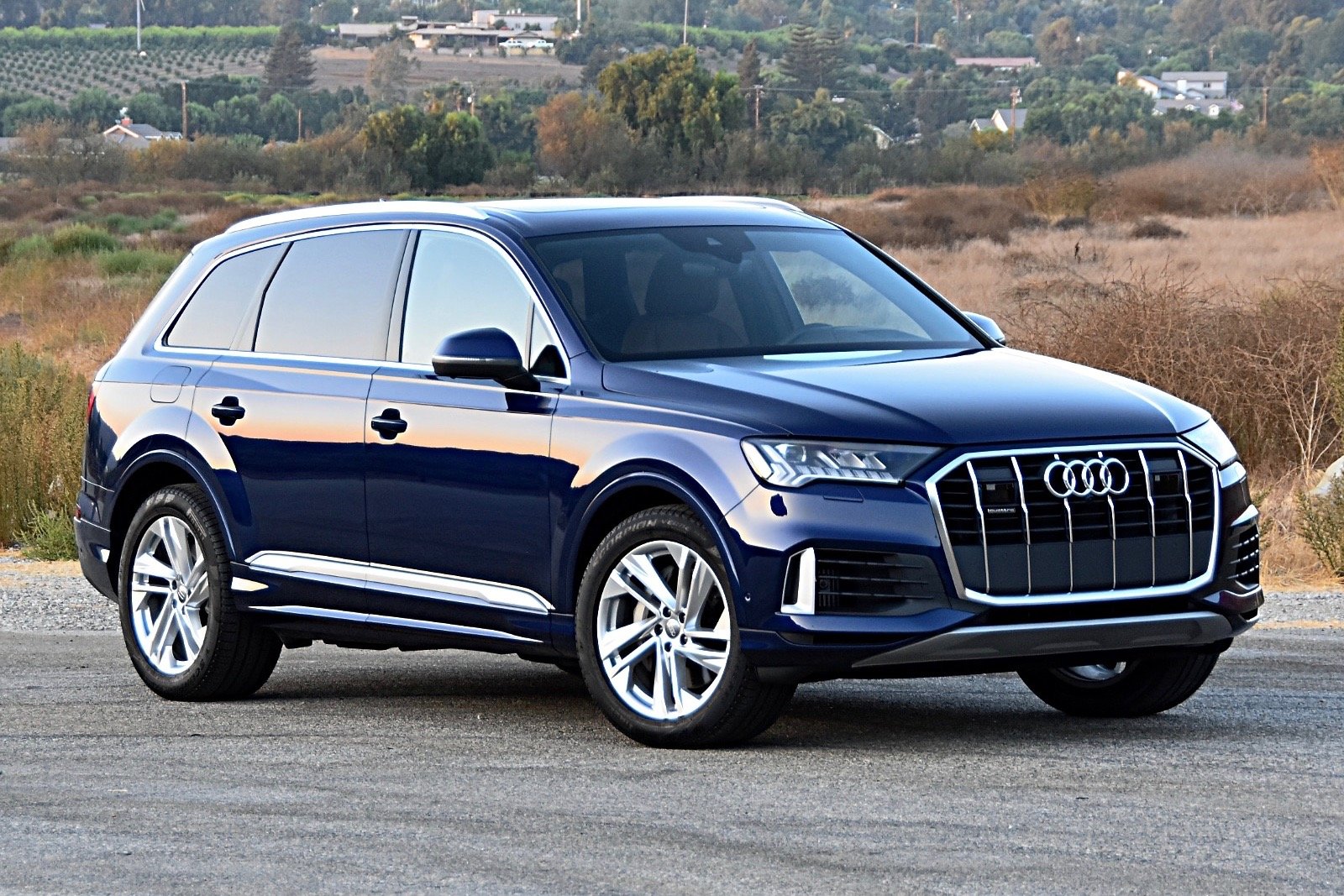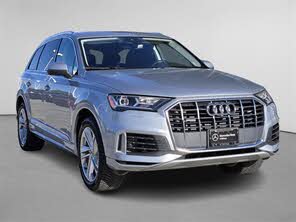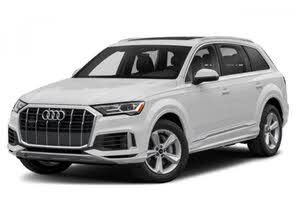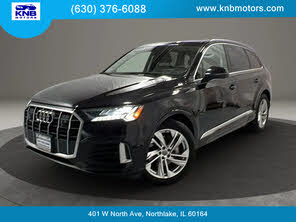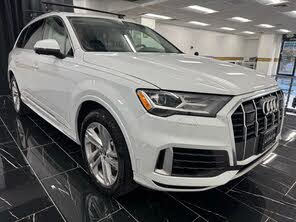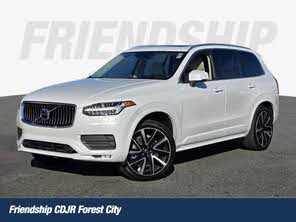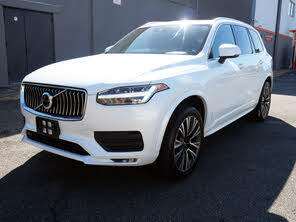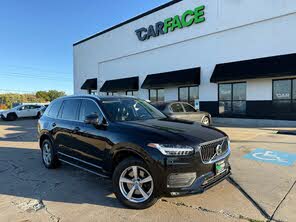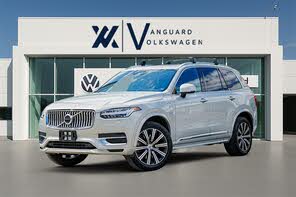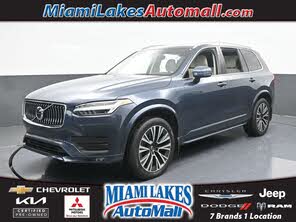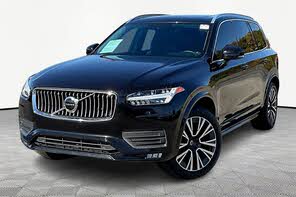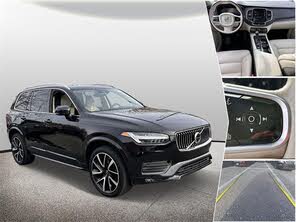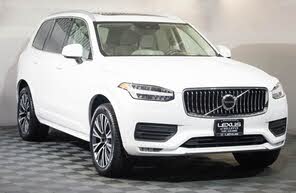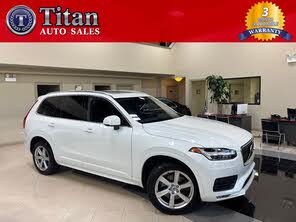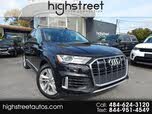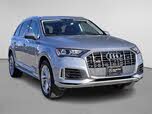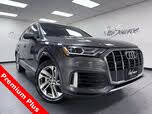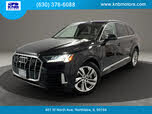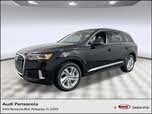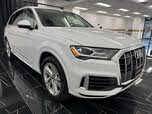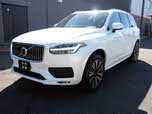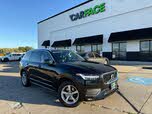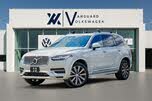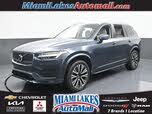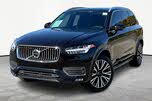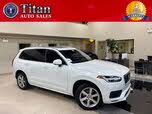2020 Audi Q7 vs 2020 Volvo XC90
Overview | |
MSRP$48,350 | MSRP$54,800 |
Listings295 | Listings101 |
Ratings & Reviews | |
User Reviews | User Reviews |
Expert reviews8.5 out of 10 | Expert reviews7.7 out of 10 |
Pros
Cons
| Pros
Cons
|
2020 Volvo XC90 Reviews SummaryThe XC90 has been one of our favorite family shuttles for 18 model years. This 3-row Volvo continues for 2020 as it was during its 2016 redesign, which brought dramatic new design language, chassis architecture, electrified powertrains, infotainment, and semi-automated driving capability. Among midsize SUVs, the XC90 is among the few I would recommend without any hesitation. Families who can afford to splurge will find a stylish and pampering truck that's built upon decades of safety research, which very few automakers can match. | |
2020 Audi Q7 Reviews SummaryFrom its styling and interior to its powertrain and technology, the 2020 Audi Q7 gets a thorough update that brings it in line with other high-end cars and SUVs wearing four chrome rings on their grilles. Simultaneously, the changes for the 2020 model year keep this Audi competitive against the BMW X5 and Mercedes-Benz GLE-Class, its primary rivals in the midsize luxury SUV class. We packed a Q7 Prestige full of family and luggage and set off for Lake Tahoe to assess this Audi’s improvements on the open road. | |
No video found | |
Popular Features & Specs | |
Engine2.0L 250 hp I4 | Engine2.0L 248 hp I4 |
Drive TrainFWD | Drive TrainAWD |
Seating Capacity7 | Seating Capacity7 |
Horsepower250 hp @ 5500 rpm | Horsepower248 hp @ 5000 rpm |
MPG City21 | MPG City19 |
MPG Highway30 | MPG Highway23 |
Engine | |
Engine Name2.0L 250 hp I4 | Engine Name2.0L 248 hp I4 |
Torque258 lb-ft @ 1500 rpm | Torque273 lb-ft @ 1600 rpm |
Horsepower250 hp @ 5500 rpm | Horsepower248 hp @ 5000 rpm |
DrivetrainFWD | DrivetrainAWD |
Fuel Economy | |
MPG City21 | MPG City19 |
MPG Highway30 | MPG Highway23 |
Interior | |
Leather Seats | Leather SeatsStandard |
Seating Capacity7 | Seating Capacity7 |
Key Features | |
Navigation System | Navigation SystemStandard |
Sunroof/MoonroofStandard | Sunroof/MoonroofStandard |
Safety | |
Front Crash Overall5 | Front Crash Overall |
Side Crash Overall5 | Side Crash Overall5 |
Dimensions & Capacity | |
Cargo Space15.8 cu ft | Cargo Space14.2 cu ft |
Curb Weight4375 lbs | Curb Weight4784 lbs |
Height69.9 in | Height68.5 in |
Length195.0 in | Length199.6 in |
Width84.3 in | Width87.1 in |
Wheelbase117.5 in | Wheelbase117.9 in |
Maximum Payload1210 lbs | Maximum Payload1367 lbs |
Number of doors4 | Number of doors4 |
Maximum Towing Capacity4000 lbs | Maximum Towing Capacity4400 lbs |
Overview | ||
MSRP | $48,350 | $54,800 |
Listings | ||
Ratings & Reviews | ||
User reviews | ||
Expert reviews | 8.5 out of 10Read full review | 7.7 out of 10Read full review |
Pros & cons | Pros
Cons
| Pros
Cons
|
Summary | The XC90 has been one of our favorite family shuttles for 18 model years. This 3-row Volvo continues for 2020 as it was during its 2016 redesign, which brought dramatic new design language, chassis architecture, electrified powertrains, infotainment, and semi-automated driving capability. Among midsize SUVs, the XC90 is among the few I would recommend without any hesitation. Families who can afford to splurge will find a stylish and pampering truck that's built upon decades of safety research, which very few automakers can match. | From its styling and interior to its powertrain and technology, the 2020 Audi Q7 gets a thorough update that brings it in line with other high-end cars and SUVs wearing four chrome rings on their grilles. Simultaneously, the changes for the 2020 model year keep this Audi competitive against the BMW X5 and Mercedes-Benz GLE-Class, its primary rivals in the midsize luxury SUV class. We packed a Q7 Prestige full of family and luggage and set off for Lake Tahoe to assess this Audi’s improvements on the open road. |
Video | No video found | |
Popular Features & Specs | ||
Engine | 2.0L 250 hp I4 | 2.0L 248 hp I4 |
Drive Train | FWD | AWD |
Seating Capacity | 7 | 7 |
Horsepower | 250 hp @ 5500 rpm | 248 hp @ 5000 rpm |
MPG City | 21 | 19 |
MPG Highway | 30 | 23 |
Engine | ||
Engine Name | 2.0L 250 hp I4 | 2.0L 248 hp I4 |
Torque | 258 lb-ft @ 1500 rpm | 273 lb-ft @ 1600 rpm |
Horsepower | 250 hp @ 5500 rpm | 248 hp @ 5000 rpm |
Drivetrain | FWD | AWD |
Fuel Economy | ||
MPG City | 21 | 19 |
MPG Highway | 30 | 23 |
Interior | ||
Leather Seats | Standard | |
Seating Capacity | 7 | 7 |
Key Features | ||
Navigation System | Standard | |
Sunroof/Moonroof | Standard | Standard |
Safety | ||
Front Crash Overall | 5 | |
Side Crash Overall | 5 | 5 |
Dimensions & Capacity | ||
Cargo Space | 15.8 cu ft | 14.2 cu ft |
Curb Weight | 4375 lbs | 4784 lbs |
Height | 69.9 in | 68.5 in |
Length | 195.0 in | 199.6 in |
Width | 84.3 in | 87.1 in |
Wheelbase | 117.5 in | 117.9 in |
Maximum Payload | 1210 lbs | 1367 lbs |
Number of doors | 4 | 4 |
Maximum Towing Capacity | 4000 lbs | 4400 lbs |
The 2020 Volvo XC90 emerged as a testament to Volvo's design evolution. Unlike the boxy designs characteristic of earlier decades, the 2020 XC90 showcased a sophisticated and aesthetically pleasing design. The model tested, the R-Design trim, featured a distinctive blacked-out, honeycomb grille treatment, black window surrounds, and mirrors that complemented its aggressive stance. The addition of 22-inch bright rims added a luxurious touch to its already elegant silhouette. Standard "Thor's Hammer" LED headlights and curvaceous LED taillights distinctly marked it as a Volvo, enhancing its nighttime visibility and appeal. The vehicle's exterior was painted in Thunder Grey Metallic, a unique shade with a subtle blue hue that elevated its presence. Inside, the XC90 boasted a refined beige-leather and aluminum interior, offering a premium environment. Volvo's attention to detail was evident in the craftsmanship, from the Swedish flag tags on the seats to the leather-wrapped center console, reinforcing a theme of simplistic luxury throughout.
In contrast, the 2020 Audi Q7 displayed a fresh look with updates to its front and rear styling, aligning it with the design language introduced by the flagship Q8 model. The Q7 featured 20-inch turbine-style wheels and new lighting elements, enhancing its road presence. The vehicle was painted in Navarra Blue metallic, a choice that accentuated its refined lines. Inside, the Q7 adopted the high-tech, minimalist dashboard from the Q8, emphasizing digital interactions with its triple-screen setup. This included Audi’s Virtual Cockpit and two touch-sensitive screens on the center console, which modernized the cabin but attracted fingerprints and dust. The interior was outfitted in Okapi Brown leather with Fine Grain Ash wood inlays, creating an upscale and inviting atmosphere. Multi-color ambient lighting further enhanced the cabin's ambiance at night.


















The Volvo XC90 was available with three powertrains, all based around a turbocharged 2.0-liter inline-4 engine paired with an 8-speed automatic transmission. The T6 model, equipped with both a supercharger and turbocharger, was rated at 316 horsepower and 295 pound-feet of torque, adequate for lively highway maneuvers. A notable enhancement was the Polestar tune, which increased output to 330 horsepower and 325 pound-feet of torque. Despite these figures, the XC90 did not deliver a sporty performance, emphasizing comfort over agility. The fuel economy was less impressive, with the T6 AWD model achieving an EPA-estimated 21 mpg combined. The T8 plug-in hybrid variant offered a more eco-friendly alternative with 400 horsepower and 472 pound-feet of torque, yet its performance did not justify the cost for many due to the limited electric range and added weight.
The Audi Q7 55 TFSI was powered by a new 3.0-liter turbocharged V6 engine producing 335 horsepower and 369 pound-feet of torque, supplemented by a 48-volt mild-hybrid system to enhance fuel efficiency. This setup enabled robust performance, with the SUV accelerating from zero to 60 mph in 5.7 seconds. The mild-hybrid technology also supported features like extended engine stop/start functionality, which helped conserve fuel without sacrificing comfort. The Q7's all-wheel-drive system and adjustable driving modes, including a Dynamic setting, provided a responsive and engaging driving experience, especially on winding roads. Its fuel economy was comparable to the XC90, with the SUV averaging 21 mpg during extensive road tests.
The Volvo XC90's interior was thoughtfully designed with functionality in mind. Its Sensus infotainment system was responsive and user-friendly, although it centralized many controls within the touchscreen, limiting physical button interactions. The XC90 offered three rows of seating, with the standard configuration accommodating up to seven passengers. The integrated booster cushion for children was a unique and practical feature. Cargo space was generous, offering up to 85.7 cubic feet with the rear seats folded, providing ample room for luggage and gear.
The Audi Q7, while also featuring three rows, was more practical as a five-passenger vehicle due to the cramped third-row seating. When not in use, the third-row could be folded down to expand cargo capacity significantly from 14.2 to 69.6 cubic feet. The front and second-row seats provided exceptional comfort and support, essential for long journeys. However, the Q7 lacked practical interior storage solutions, which could be a drawback for families needing ample space for personal items.
Volvo equipped the XC90 with advanced technology features, including the Pilot Assist system, which combined adaptive cruise control and lane-keeping assist for a semi-autonomous driving experience. The Bowers & Wilkins audio system, with its 19 speakers and 1,400 watts of power, offered an unmatched auditory experience. The XC90's four-zone climate control and high-resolution touchscreen added to its luxurious feel, though the infotainment system's ability to integrate
deeply with vehicle settings and apps could be improved.
Audi's Q7 featured the updated MMI Touch Response system, providing a more intuitive interface with upper and lower touchscreens. This system supported natural voice and handwriting recognition, enhancing user interaction. The integration of wireless Apple CarPlay and Android Auto, along with Audi Connect services, offered comprehensive connectivity options. The vehicle's high-tech equipment, including the optional Bose sound system, provided both functionality and entertainment on the go.
The Volvo XC90 boasted excellent safety ratings, with top scores from both the NHTSA and IIHS. Standard safety features included forward emergency braking, pedestrian detection, and a whiplash protection system, reflecting Volvo's commitment to passenger safety through robust engineering and ethical considerations.
The Audi Q7 also offered impressive safety credentials, with advanced driving-assistance systems enhancing the driving experience. However, its HD Matrix LED headlights received a "poor" rating from the IIHS due to glare issues, despite their effectiveness in low-light conditions. The SUV's array of safety technologies, including Emergency Assist and Adaptive Cruise Assist, provided substantial support for drivers, although some features like traffic-sign recognition were not always reliable.
CarGurus highlights

According to CarGurus experts, the overall rating for the 2020 Volvo XC90 is 8.5 out of 10, while the 2020 Audi Q7 scores 7.7 out of 10. Based on these ratings, the Volvo XC90 comes out on top as the preferred choice. Its blend of safety, design, and family-oriented features makes it a more appealing option for consumers looking for a well-rounded luxury SUV.
Choose the 2020 Audi Q7 if:
- You seek a vehicle with a robust and responsive powertrain enhanced by mild-hybrid technology.
- You appreciate advanced infotainment systems with intuitive controls and connectivity.
- You enjoy driving dynamics that are well-suited for both highway cruising and spirited driving on twisty roads.
Choose the 2020 Volvo XC90 if:
- You value a car with a strong safety reputation and innovative safety features.
- You prefer a more traditional luxury interior with thoughtful craftsmanship and details.
- You need a versatile family SUV with practical solutions like an integrated booster seat.
CarGurus highlights

According to CarGurus experts, the overall rating for the 2020 Volvo XC90 is 8.5 out of 10, while the 2020 Audi Q7 scores 7.7 out of 10. Based on these ratings, the Volvo XC90 comes out on top as the preferred choice. Its blend of safety, design, and family-oriented features makes it a more appealing option for consumers looking for a well-rounded luxury SUV.
Choose the 2020 Audi Q7 if:
Shop Now- You seek a vehicle with a robust and responsive powertrain enhanced by mild-hybrid technology.
- You appreciate advanced infotainment systems with intuitive controls and connectivity.
- You enjoy driving dynamics that are well-suited for both highway cruising and spirited driving on twisty roads.
Choose the 2020 Volvo XC90 if:
Shop Now- You value a car with a strong safety reputation and innovative safety features.
- You prefer a more traditional luxury interior with thoughtful craftsmanship and details.
- You need a versatile family SUV with practical solutions like an integrated booster seat.

By: CarGurus + AI
At CarGurus, our team of experienced automotive writers remain at the heart of our content operation, conducting hands-on car tests and writing insightful guides that are backed by years of industry experience. To complement this, we are harnessing AI to make our content offering more diverse and more helpful to shoppers than ever. To achieve this, our AI systems are based exclusively on CarGurus content, ratings and data, so that what we produce is both unique to CarGurus, and uniquely helpful to car shoppers.
